

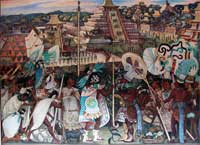
|
The setting: El TajínSee these pages for more information on the archaeological site of El Tajín. The central foreground event depicts either an Aztec chieftan collecting tribute (official guide) or "merchants on an expedition to exchange products, including fruit, crafts, wild game and clothing" (Rodríguez 79). | |
Left: one of the many ballcourts at El Tajín; center: Pyramid of the Niches with the flying man gameSee this page for more information and views of the Pyramid of the Niches and this page for views of the South Ball Court and this page for views of other ball courts at the site. The ritual game "Volador" or Flyer featured dancers with rope tied to their ankles swinging from a tall pole and circling it as they gradually rotated to the ground. | ||

|
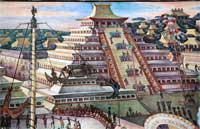
|

|
The central groupRodríguez explains that "the figure who leads the Totonac 'delegation' [to the right] wears a belt from which projects a prominent, curved blade which evokes the stone yokes and palmate stones of Totonac and Huastec sculpture" while the leader on the left of the Mexica group "is dressed as Yacatecuhtli, patron god of the pochteca" (79). The image to the left (below) shows the statue carried by this group of that god in a similar costume. | ||
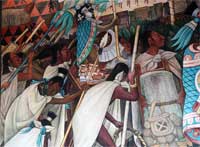
|
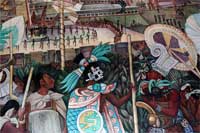
|

|
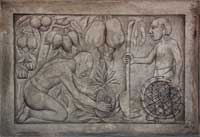
|
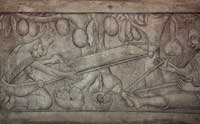
|
The grisailles below the polychrome panelThe Indians are shown in their everyday life, on the left cultivating pineapple and tamarind, and in the center weaving with a back-strap loom. |
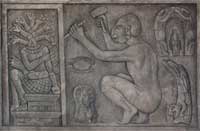
|
A sculptorRodríguez explains that the sculptor depicted in this grisaille has designed the famous Aparicio Slab of Veracruz which depicts streams of blood in the form of serpents emanating from the neck of the decapitated ballplayer. A stone yoke and palmate stones are around the sculptor (79). | |
 Go to Rivera Murals Index.
Go to Rivera Murals Index.
 Go to the Mexico Index.
Go to the Mexico Index.
 Click here to return to index of art historical sites.
Click here to return to index of art historical sites.
 Click here to return to index of artists and architects.
Click here to return to index of artists and architects.
 Click here to return to chronological index.
Click here to return to chronological index.
 Click here to see the home page of Bluffton University.
Click here to see the home page of Bluffton University.

